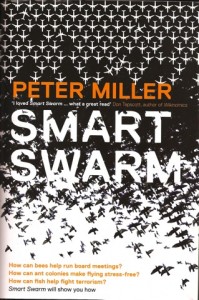The one-sentence summary
Understanding flocks, schools and colonies can make us better at communicating, decision-making and getting things done.
WHAT THE BOOK SAYS 
- Understanding how flocks, schools and colonies work can make us better at communicating, decision-making and getting things done.
- Studying the collective intelligence of ants, bees, termites, birds, fish, and locusts can give us great ideas for solving business and social problems. Many of them have already been adopted by the worlds of finance, the military, and even Google.
- The major principles of a smart swarm are:
1. Self-organization – this is made up of decentralized control (nobody’s in charge), distributed problem-solving (each individual sorts something out), and multiple interactions (lots of individuals paying attention to what the other is doing).
2. Diversity of knowledge – when many bees head in different directions looking for honey, they increase the hive’s collective chance of finding it.
3. Indirect collaboration – in a process sometimes called stigmergy, termites follow a simple rule of ‘drop your grain of sand here if somebody else has already done so.’ The collaboration is indirect because they do not have to interact with a colleague for this to occur, and the communication is achieved indirectly by modifying the environment.
4. Adaptive mimicking – coordination, communication and copying can unleash powerful waves of energy in a collective population
WHAT’S GOOD ABOUT IT
- Amplifying success is a helpful concept. The more ants take the shortest path, the more continue to do so, thus increasing efficiency. This can be emulated in the business world.
- Swarm lessons are salutary:
– Seek a diversity of knowledge
– Encourage a friendly competition of ideas
– Use an effective mechanism to narrow your choices
- Many businesses are like a complex adaptive organism without a central nervous system, with units operating in silos and not sharing knowledge.
- It is proven that groups of 3-4 people perform better than the best individual because their sum total of problem-solving skills is greater.
WHAT YOU HAVE TO WATCH
- It is not laid out like a business book with easy captions in bold – you have to dig for these findings, but it’s worth it.
